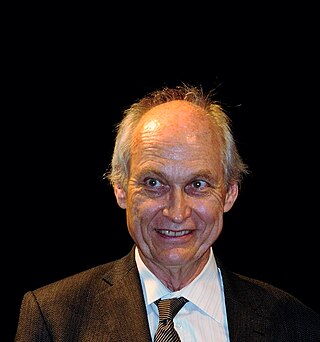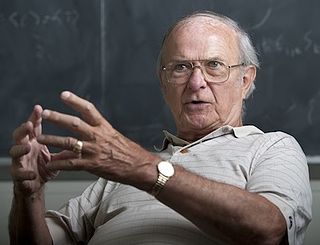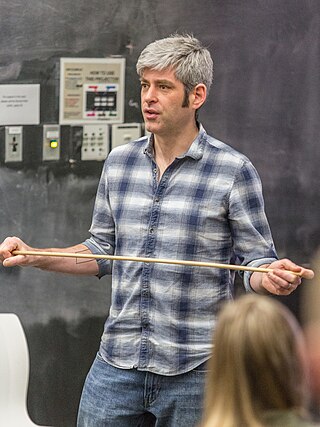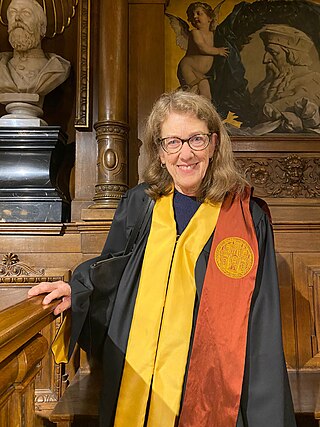
Particle physics or high energy physics is the study of fundamental particles and forces that constitute matter and radiation. The fundamental particles in the universe are classified in the Standard Model as fermions and bosons. There are three generations of fermions, although ordinary matter is made only from the first fermion generation. The first generation consists of up and down quarks which form protons and neutrons, and electrons and electron neutrinos. The three fundamental interactions known to be mediated by bosons are electromagnetism, the weak interaction, and the strong interaction.

Michael S. Turner is an American theoretical cosmologist who coined the term dark energy in 1998. He is the Rauner Distinguished Service Professor Emeritus of Physics at the University of Chicago, having previously served as the Bruce V. & Diana M. Rauner Distinguished Service Professor, and as the assistant director for Mathematical and Physical Sciences for the US National Science Foundation.

Maria Spiropulu is a Greek particle physicist. She is the Shang-Yi Ch'en Professor of Physics at the California Institute of Technology.

Carl Richard Hagen is a professor of particle physics at the University of Rochester. He is most noted for his contributions to the Standard Model and Symmetry breaking as well as the 1964 co-discovery of the Higgs mechanism and Higgs boson with Gerald Guralnik and Tom Kibble (GHK). As part of Physical Review Letters 50th anniversary celebration, the journal recognized this discovery as one of the milestone papers in PRL history. While widely considered to have authored the most complete of the early papers on the Higgs theory, GHK were controversially not included in the 2013 Nobel Prize in Physics.

Chris Quigg is an American theoretical physicist at the Fermi National Accelerator Laboratory (Fermilab). He graduated from Yale University in 1966 and received his Ph.D. in 1970 under the tutelage of J. D. Jackson at the University of California, Berkeley. He has been an associate professor at the Institute for Theoretical Physics, State University of New York, Stony Brook, and was head of the Theoretical Physics Department at Fermilab from 1977 to 1987.

Joseph David Lykken is an American theoretical physicist at the Fermi National Accelerator Laboratory and, from July 1, 2014 to Sept 6, 2022, he was the Deputy Director of Fermilab. He is currently leading the Fermilab Quantum Institute.

Fabiola Gianotti is an Italian experimental particle physicist who is the current and first woman Director-General at CERN in Switzerland. Her first mandate began on 1 January 2016 and ran for a period of five years. At its 195th Session in 2019, the CERN Council selected Gianotti for a second term as Director-General. Her second five-year term began on 1 January 2021 and goes on until 2025. This is the first time in CERN's history that a Director-General has been appointed for a full second term.
Carlos Wagner is a particle physicist. He specializes in theoretical physics, elementary particles and supersymmetric theories. He currently works for the High Energy Physics (HEP) division of the Argonne National Laboratory and is also a professor at the Physics Department of the University of Chicago, Enrico Fermi Institute, and the Kavli Institute for Cosmological Physics, University of Chicago. He also functions as the Head of the ANL High Energy Physics Theory Group.

Don Lincoln is an American physicist, author, host of the YouTube channel Fermilab, and science communicator. He conducts research in particle physics at Fermi National Accelerator Laboratory, and was an adjunct professor of physics at the University of Notre Dame, although he is no longer affiliated with the university. He received a Ph.D. in experimental particle physics from Rice University in 1994. In 1995, he was a co-discoverer of the top quark. He has co-authored hundreds of research papers, and more recently, was a member of the team that discovered the Higgs boson in 2012.

Guido Tonelli is an Italian particle physicist who was involved with the discovery of the Higgs boson at the Large Hadron Collider. He is a professor of General Physics at the University of Pisa (Italy) and a CERN visiting scientist.

Sau Lan Wu is a Chinese American particle physicist and the Enrico Fermi Distinguished Professor of Physics at the University of Wisconsin-Madison. She made important contributions towards the discovery of the J/psi particle, which provided experimental evidence for the existence of the charm quark, and the gluon, the vector boson of the strong force in the Standard Model of physics. Recently, her team located at the European Organization for Nuclear Research (CERN), using data collected at the Large Hadron Collider (LHC), was part of the international effort in the discovery of a boson consistent with the Higgs boson.

Yasunori Nomura is a theoretical physicist working on particle physics, quantum gravity, and cosmology. He is a professor of physics at University of California, Berkeley, a senior faculty scientist at Lawrence Berkeley National Laboratory, a senior research scientist at Riken, and an affiliate member at Kavli Institute for the Physics and Mathematics of the Universe. Since 2015, he has been the director of the Berkeley Center for Theoretical Physics.

Daniel Wayne Hooper is an American cosmologist and particle physicist specializing in the areas of dark matter, cosmic rays, and neutrino astrophysics. He is a senior scientist at Fermi National Accelerator Laboratory and a professor of astronomy and astrophysics at the University of Chicago.

Sally Dawson is an American physicist who deals with theoretical elementary particle physics.

Beate Heinemann is a German particle physicist who has held positions at universities in Europe and the United States. She currently holds a joint appointment at two German institutions, Albert Ludwigs University of Freiburg and the DESY laboratory in Hamburg.
Natalie Ann Roe is an experimental particle physicist and observational cosmologist, and the Associate Laboratory Director for the Physical Sciences Area at Lawrence Berkeley National Laboratory (LBNL) since 2020. Previously, she was the Physics Division Director for eight years. She has been awarded as the Fellow of American Physical Society (APS) and American Association for the Advancement of Science (AAAS) for her exceptional scientific career and contributions.
Joshua A. Frieman is a theoretical astrophysicist who lives and works in the United States. He is a senior scientist at Fermilab and a professor of astronomy and astrophysics at the University of Chicago. Frieman is known for his work studying dark energy and cosmology, and he co-founded the Dark Energy Survey experiment. He was elected a member of the National Academy of Sciences in 2022.

Meenakshi Narain was an Indian-born American experimental physicist. She was a Professor of Physics and Chair of the Department of Physics at Brown University, and was also Chair of the Collaboration Board of U.S. institutions in the Compact Muon Solenoid (CMS) Collaboration. She contributed to the discovery of the top quark in 1995 and Higgs Boson in 2012.
Julia Apostolova Velkovska is a Bulgarian-American high energy particle physicist who is the Cornelius Vanderbilt Professor of Physics at Vanderbilt University. Her research considers nuclear matter in the extreme conditions generated at the Relativistic Heavy Ion Collider. She hopes that this work will help to explain the mechanisms that underpin the strong force.
Cecilia Elena Gerber is an Argentine-American experimental high-energy physicist whose research involves massive elementary particles: the top quark and Higgs boson. She is UIC Distinguished Professor of Physics and director of undergraduate studies in physics at the University of Illinois Chicago, and the co-director of the LHC Physics Center at Fermilab. Her research has included participation in the DØ experiment at Fermilab and the Compact Muon Solenoid experiment at the Large Hadron Collider in France and Switzerland.















